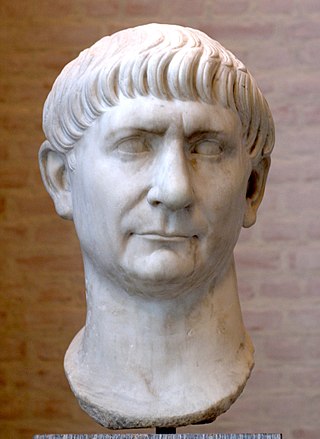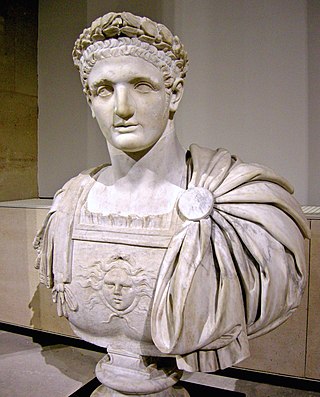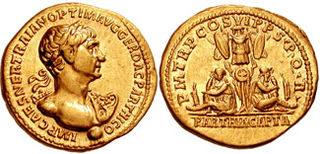
Hadrian was Roman emperor from 117 to 138. Hadrian was born in Italica, close to modern Seville in Spain, an Italic settlement in Hispania Baetica; his branch of the Aelia gens, the Aeli Hadriani, came from the town of Hadria in eastern Italy. He was a member of the Nerva-Antonine dynasty.

Lucius Septimius Severus was a Roman politician who served as emperor from 193 to 211. He was born in Leptis Magna in the Roman province of Africa. As a young man he advanced through the customary succession of offices under the reigns of Marcus Aurelius and Commodus. Severus seized power after the death of the emperor Pertinax in 193 during the Year of the Five Emperors.

Trajan was Roman emperor from AD 98 to 117, the second of the Five Good Emperors of the Nerva–Antonine dynasty. He was a philanthropic ruler and a successful soldier-emperor who led the Roman Empire to its greatest territorial extent by the time of his death. He was given the title of optimus by the Roman Senate.

The 2nd century is the period from AD 101 through AD 200 (CC) in accordance with the Julian calendar. It is considered part of the Classical era, epoch, or historical period.

The 90s was a decade that ran from January 1, AD 90, to December 31, AD 99.

The 100s was a decade that ran from January 1, AD 100, to December 31, AD 109.

The 110s was a decade that ran from January 1, AD 110, to December 31, AD 119.

The 120s was a decade that ran from January 1, AD 120, to December 31, AD 129.
AD 98 (XCVIII) was a common year starting on Monday of the Julian calendar. At the time, it was known as the Year of the Consulship of Augustus and Traianus. The denomination AD 98 for this year has been used since the early medieval period, when the Anno Domini calendar era became the prevalent method in Europe for naming years.

AD 100 (C) was a leap year starting on Wednesday of the Julian calendar. In the Roman Empire, it was sometimes referred to as year 853 ab urbe condita, i.e., 853 years since the founding of Rome in 753 B.C. The denomination AD 100 for this year has been used since the early medieval period, when the Anno Domini calendar era became the prevalent method in Europe for naming years.
The 190s decade ran from January 1, 190, to December 31, 199.
Year 138 (CXXXVIII) was a common year starting on Tuesday of the Julian calendar. At the time, it was known as the Year of the Consulship of Niger and Camerinus. The denomination 138 for this year has been used since the early medieval period, when the Anno Domini calendar era became the prevalent method in Europe for naming years.

The Kitos War was one of the major Jewish–Roman wars (66–136). The rebellions erupted in 115 when most of the Roman armies were fighting Trajan's Parthian War on the eastern border of the Roman Empire. Major uprisings by Jews in Cyrenaica, Cyprus and Egypt spiralled out of control, resulting in a widespread slaughter of the remaining Roman garrisons and Roman citizens by Jewish rebels.
Quintus Marcius Turbo was prefect of the Praetorian Guard and a close friend and military advisor to both emperor Trajan and Hadrian during the early 2nd century.

The Nerva–Antonine dynasty comprised seven Roman emperors who ruled from AD 96 to 192: Nerva (96–98), Trajan (98–117), Hadrian (117–138), Antoninus Pius (138–161), Marcus Aurelius (161–180), Lucius Verus (161–169), and Commodus (177–192). The first five of these are commonly known as the "Five Good Emperors".

Relations between the Roman and Iranian states were established c. 92 BC. It was in 69 BC that the two states clashed for the first time; the political rivalry between the two empires would dominate much of Western Asia and Europe until 628. Initially commencing as a rivalry between the Parthians and Rome, from the 3rd to mid-7th centuries the Roman Empire and its rival Sassanid Persia were recognized as two of the leading powers in the world.

Assyria was a short-lived Roman province in Mesopotamia that was created by Trajan in 116 during his campaign against the Parthian Empire. After Trajan's death, the newly proclaimed emperor Hadrian ordered the evacuation of Assyria in 118.
The Roman–Parthian Wars were a series of conflicts between the Parthian Empire and the Roman Republic and Roman Empire. It was the first series of conflicts in what would be 682 years of Roman–Persian Wars.
Romans in Persia is related to the brief invasion and occupation of western and central areas of Parthia by the Romans during their empire. Emperor Trajan was even temporarily able to nominate a king of western parts of Parthia, Parthamaspates, as ruler of a Roman "client state" in Parthia.

Trajan's Parthian campaign was engaged by Roman Emperor Trajan in 115 against the Parthian Empire in Mesopotamia. The war was initially successful for the Romans, but a series of setbacks, including wide-scale rebellions in the Eastern Mediterranean and North Africa and Trajan's death in 117, ended in a Roman withdrawal.













